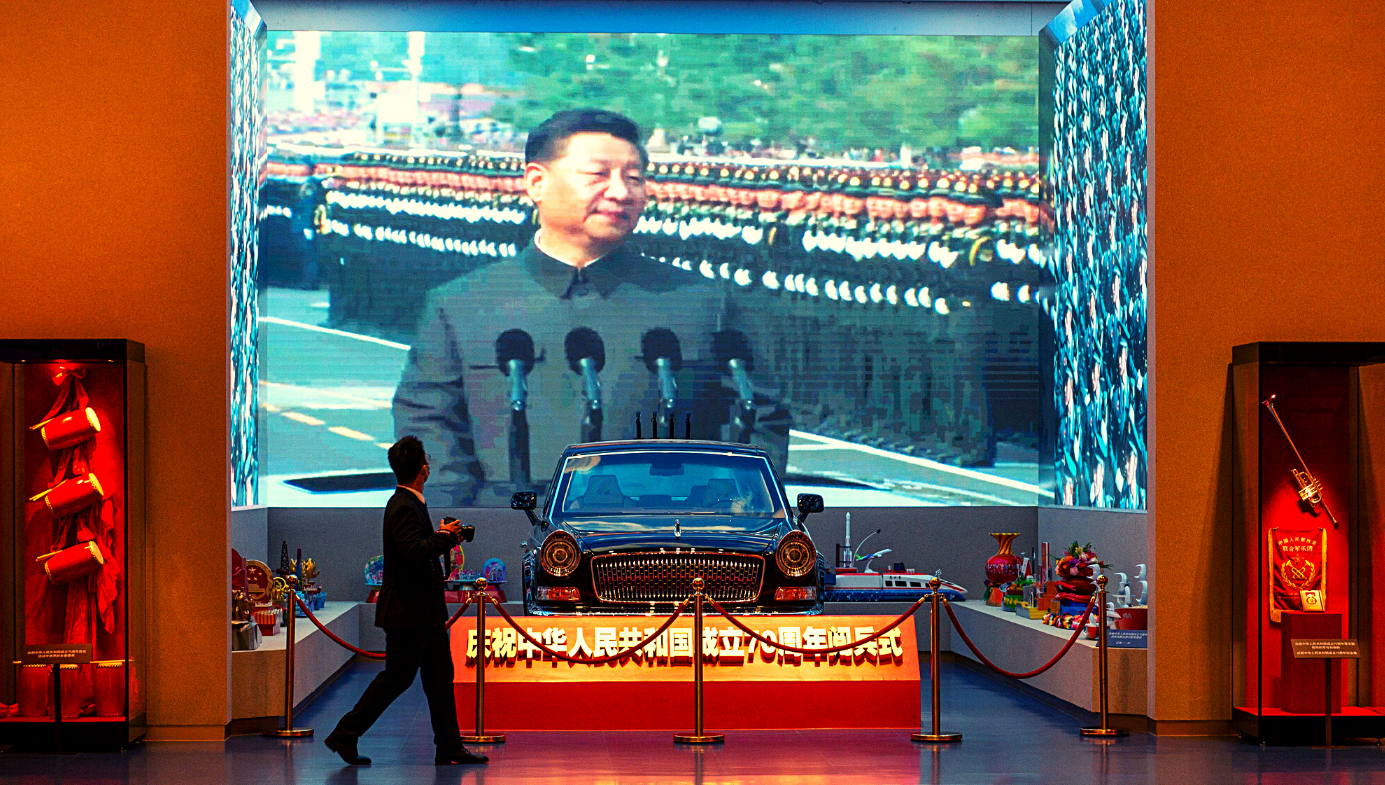Politics
Welcome to Cold War II
Challenging China across the technological landscape requires a mammoth effort.

In early June, with little fanfare or press coverage, the US Senate passed a 2,400-page bill called “The United States Innovation and Competition Act (USICA).” Heralded as “the most significant government intervention in industrial policy in decades,” the bill will pump over $200 billion into a diverse spectrum of R&D initiatives over the next five years with the sole purpose of bolstering “competitiveness against China.”
The COVID-19 pandemic revealed the alarming extent of America’s dependence on foreign countries. Nowhere was this more apparent or more dire than in the provision of personal protective equipment (PPE) such as medical masks. “Medical supply chains that span oceans and continents,” note Martha Mendoza and Juliet Linderman in an article for PBS Frontline, “are the fragile lifelines between raw materials and manufacturers overseas, and healthcare workers on COVID-19 front lines in the US. As link after link broke, the system fell apart.” Mendoza and Linderman’s joint coverage of the issue followed a months-long investigation and reveals just how vulnerable America allowed itself to become. As the world turned inwards and borders began to close, complex global supply chains were paralyzed. Locked-down countries had entire industrial sectors knocked out at the very moment they were most needed. It wasn’t until February 2020, nearly three months after COVID-19 cases began to appear, that China restarted its medical factories.
This, as it turned out, was a problem unknown to many Americans. Even prior to the coronavirus, China manufactured well over half of the world’s masks. It has since “expanded production nearly 12-fold since then,” Keith Bradsher and Liz Alderman report in the New York Times. Moreover, China “bought up much of the rest of the world’s supply,” importing 56 million respirators and masks following the January lockdown in Wuhan. China’s medical dominance also accounts for over 60 percent of global antibiotics and sedative exports.
China—like any country—looked after its own citizens first. Rushing to contain COVID-19 domestically, medical supplies leaving the country shrank overnight. In February 2020, the Associated Press found a 55 percent drop in N95 imports to America as well as a 40 percent decline in hand sanitizer and swab imports. “The critical shortage of medical supplies across the US, including testing swabs, protective masks, surgical gowns and hand sanitizer, can be tied to a sudden drop in imports, mostly from China,” Mendoza and Linderman wrote in March 2020.
Once the scale of the pandemic and the importance of basic medical supplies became clear, many countries adopted a “Beggar Thy Neighbour” approach reminiscent of the Great Depression, scrambling to protect themselves at the expense of others. It wasn’t only China looking after its own interests; American allies including South Korea, India, Taiwan, France, and the United Kingdom all imposed export restrictions on a host of coronavirus-related products. The US was no different. President Trump invoked the Korean War-era Defence Production Act and demanded that 3M halt exports of N95 masks to Canada and Latin America.
Government officials had long been warning of a scenario like this. “For decades, politicians and corporate officials ignored warnings about the risks associated with America’s over-dependence on foreign manufacturing, and a lack of adequate preparation at home,” Mendoza and Linderman contend. Unfortunately, it took the worst pandemic in a century and over half-a-million deaths for America to wake up.
The same goes for semiconductors. During lockdown, the thirst for chips to power our smartphones, laptops, TVs, and PlayStations logjammed the market. The automotive industry was particularly badly hit. GM announced in February that it was shutting down three manufacturing plants and slowing production at a fourth because of the semiconductor crunch. They aren’t alone. The production cycle of semiconductors and their long turnarounds have led other American giants such as Ford and Fiat Chrysler to scale back, too.
The pandemic spotlighted the unforeseen effects interdependence and protectionism could have in times of crisis, which prompted President Biden to sign an executive order earlier this year reviewing global supply chains and boosting domestic production of semiconductors.
* * *
It was once fashionable to deride those who warned about the perils of over-dependence on other countries. “Made in America” or “Buy American” became codewords for xenophobia on the heels of Trump’s 2016 election. In 2017, one historian urged Washington Post readers to remember that the “dark side” of such rhetoric was “often shrouded in racism.” Similar thoughts were echoed in Jacobin, the socialist publication, that same year in response to Trumpian trade policy. But dismissals like those are hard to come by these days. Perhaps it’s the media pulling punches on Biden. Maybe it’s the change in rhetoric and tone from the new administration.
In any event, the chorus denouncing self-reliance as xenophobic and racist has all but disappeared. Americans are beginning to recognize that self-sufficiency produces tangible benefits in the national interest. The coronavirus demonstrated the fickleness of supply chains and open borders. Despite the lofty rhetoric of cooperation and multilateralism, Americans learned firsthand that you better be able to build your own life raft when the flood arrives. At the very least, you shouldn’t be reliant on your biggest geopolitical foe for survival.

By April 2020, pollsters were already reporting a sea change in public opinion. Pew has documented nearly two decades of American public opinion on China. In 2005, more Americans held favourable views of China (43 percent) than unfavourable (35 percent). The American public see-sawed over subsequent years, although it remained generally favourable. However, between 2013 and 2016, over half of Americans polled came to view China unfavourably. Apart from a brief defrosting after Trump's election, trade tensions and the pandemic cemented American hostility, and by 2020, 73 percent of Americans held unfavourable views of China with only 22 percent feeling the opposite.
The past two years represent a watershed moment in American perceptions. If vulnerability at the hands of China’s medical industry wasn’t enough, the latter’s obscurantism over the origins of COVID-19 and manipulation of the World Health Organization (WHO) has pushed Americans to see China in a new light. The growing laundry list of American grievances now include cyberattacks, theft of intellectual property, and growing awareness of human rights abuses targeting Uyghur Muslims. Consequently, almost 90 percent of Americans now consider China’s power and influence to be a threat, and two-thirds see China as a “major threat.” This was more or less in line with a March 2021 Gallup poll noting a doubling of Americans who saw “China as our greatest enemy” from 22 percent to 45 percent. COVID, in other words, has made China a bipartisan issue.
The most striking re-shuffling is in the political arena. Whereas Democrats long resisted caricatures of China as a threatening peer-competitor on the global stage, their views are now aligning with Republicans. In 2019, Pew found that 70 percent of Republicans and 59 percent of Democrats held unfavourable opinions of China. The following year, the gap grew but not in any direction helpful to China—83 percent of Republicans and 68 percent of Democrats in 2020 viewed China unfavourably (very similar to numbers reported by Gallup). Fears about China’s economic ascent—and its march towards becoming “the world’s largest economy”—have made it the country of which Americans are now most fearful. The pandemic only clarified this. Simmering economic anxieties have reinforced the increasingly popular view that China is a dangerous rogue power making its own rules.
* * *
Perhaps the most striking feature of the USICA is that it was a collaboration between Democratic Senator Chuck Schumer and Republican Senator Todd Young, and passed with bipartisan backing (68–32). Amazingly, Americans are finally agreeing on something. Just months prior to the Afghanistan debacle, Schumer noted, “Either we can concede the mantle of global leadership to our adversaries or we can pave the way for another generation of American leadership.” His newfound ally, Young, expressed similar convictions. “Today we declare our intention to win this century, and those that follow it as well.”
Challenging China across the technological landscape requires a mammoth effort. According to the bill, the new frontiers of competition include artificial intelligence (AI), quantum computing, biotechnology, robotics, medical supply chains, telecommunications, satellites, semiconductors, and a host of cyber capabilities. Unfortunately, as the bill snaked its way through Congress it was watered down. Initially known as the Endless Frontier Act in 2020, it envisioned a revamped “Technology Directorate” along the lines of DARPA, the R&D moonshot agency conceived by the President Dwight Eisenhower following the Soviets’ launch of Sputnik in 1957. Amendments raised during the Senate consultations dropped the Directorate’s funding from an initial $100 billion to less than a third of that.
Its current diluted form is the result of political logrolling. Hawaii Senator Brian Schatz, for instance, introduced a preposterous motion to include a crackdown on the sale of shark fins. “Sen. Schatz … Suggests it belongs in EF because it's an anti-China bill, and China eats a lot of shark fins,” one journalist covering the proceedings tweeted. Samuel Hammond, at the Washington DC-based think-tank the Niskanen Center, sees the dilution “of one of the most important legislative proposals you’ve never heard of” as a sign of the lingering political dysfunction endemic to the Senate.
Notwithstanding the political horse-trading, one thing looks certain: politicians are finally arresting the long slide of public investment in R&D which peaked at the height of America’s technological insecurity during the Cold War. As it’s been combined with other proposals to form what is now USICA, it’s become referred to in shorthand as the “China Bill.” Following the bipartisan vote, Chinese officials condemned the bill as full of “Cold War mentality and ideological prejudice,” noting, “It slanders China’s development path and its domestic and foreign policies.”
Despite the scoffs, Niall Ferguson’s claim that we are living through the beginnings of “Cold War II” now appear prophetic. Writing in December 2020, Ferguson contended, “Tell an American audience that Cold War II has already begun, and they will mostly object.” That’s no longer the case. The Senate’s bill which some see framed too heavily along the lines of a zero-sum global competition has led the Chinese to respond in kind. Welcome to Cold War II.






